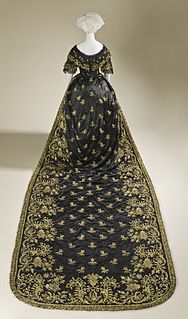 W
WThe colobium sindonis is a simple sleeveless white linen shift worn by British Monarchs during part of the Coronation service. It symbolises divesting oneself of all worldly vanity and standing bare before God.
 W
WThe official court dress of the Empire of Japan , used from the Meiji period until the end of the Second World War, consisted of European-inspired clothing in the Empire style. It was first introduced at the beginning of the Meiji period and maintained through the institution of the constitutional monarchy by the Meiji Constitution, and represented the highest uniforms in use at the time. Uniforms for members of the kazoku peerage and civil officials were officially set.
 W
WThe official court uniform and dress of the Ottoman Empire were required to be worn by those in attendance at the imperial court in the nineteenth century, with the aim of being on the same line as most European nations. It consisted of European-inspired clothing in the Empire style. It was introduced during the early stages of the Tanzimat modernization period until the end of the First World War.
 W
WCourt uniform and dress were required to be worn by those in attendance at the royal court in the 19th and early 20th centuries.
 W
WDiplomatic uniforms are ornate uniforms worn by diplomats—ambassadorial and consular officers—at public occasions. Introduced by European states around 1800 and patterned on court dress, they were abandoned by most countries in the twentieth century, but diplomats from some countries retain them for rare, formal occasions.
 W
WThe jūnihitoe , more formally and historically known as the itsutsuginu-karaginu-mo (五衣唐衣裳), is a style of formal court dress first worn in the Heian period by noble women and ladies-in-waiting at the Japanese Imperial Court. The jūnihitoe was composed of a number of kimono-like robes, layered on top of each other, with the outer robes cut both larger and thinner to reveal the layered garments underneath. These robes were referred to as hitoe, with the innermost robe - worn as underwear against the skin - known as the kosode. Hakama were also worn as underwear with the kosode; over time, the two would gradually become outerwear, with the kosode eventually developing into the modern-day kimono.
 W
WThe kabbadion was a caftan-like garment of oriental origin which became a standard part of court costume in the last centuries of the Byzantine Empire.
 W
WA kanmuri (冠) is a type of Japanese cap generally consisting of lacquer-coated black silk topped with an upright pennon. It was the standard headwear worn by adult men at the Japanese imperial court, including courtiers, aristocrats, and the emperor, from the Heian period to the Meiji Restoration. Today, it is worn only by the Imperial Family and government officials on rare occasions, such as weddings and the accession of new emperors. It is worn in conjunction with the sokutai.
 W
WMianfu, literally means "Coronation Costume", is a kind of Chinese clothing worn by emperors, princes and kings during imperial China, from the Shang Dynasty until Ming Dynasty.
 W
WPeerage robes are worn in the United Kingdom by peers and are of two varieties for two occasions: Parliament robes, worn on ceremonial occasions in the House of Lords, and Coronation robes, worn at coronations of monarchs.
 W
WThe sokutai (束帯) is a traditional Japanese outfit worn only by courtiers, aristocrats and the emperor at the Japanese imperial court. The sokutai originated in the Heian period, and consists of a number of parts, including the ho, shaku (笏), a flat ritual baton or sceptre, and the kanmuri (冠), a cap-shaped black lacquered silk hat with an upright pennon decorated with the imperial chrysanthemum crest.
 W
WIn clothing, a train describes the long back portion of a robe, coat, cloak, skirt, overskirt, or dress that trails behind the wearer.